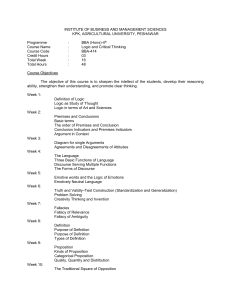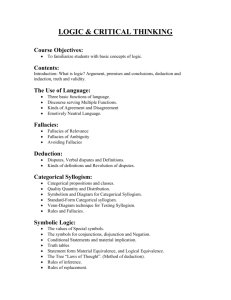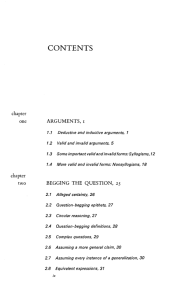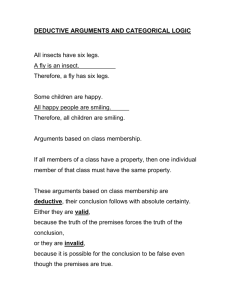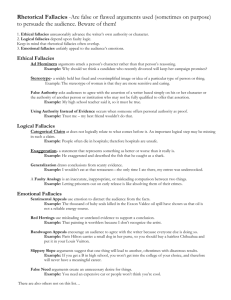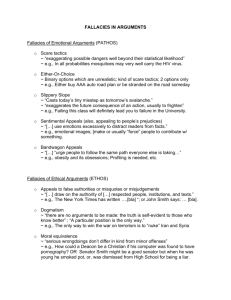PHIL 226 - Brookdale Community College
advertisement
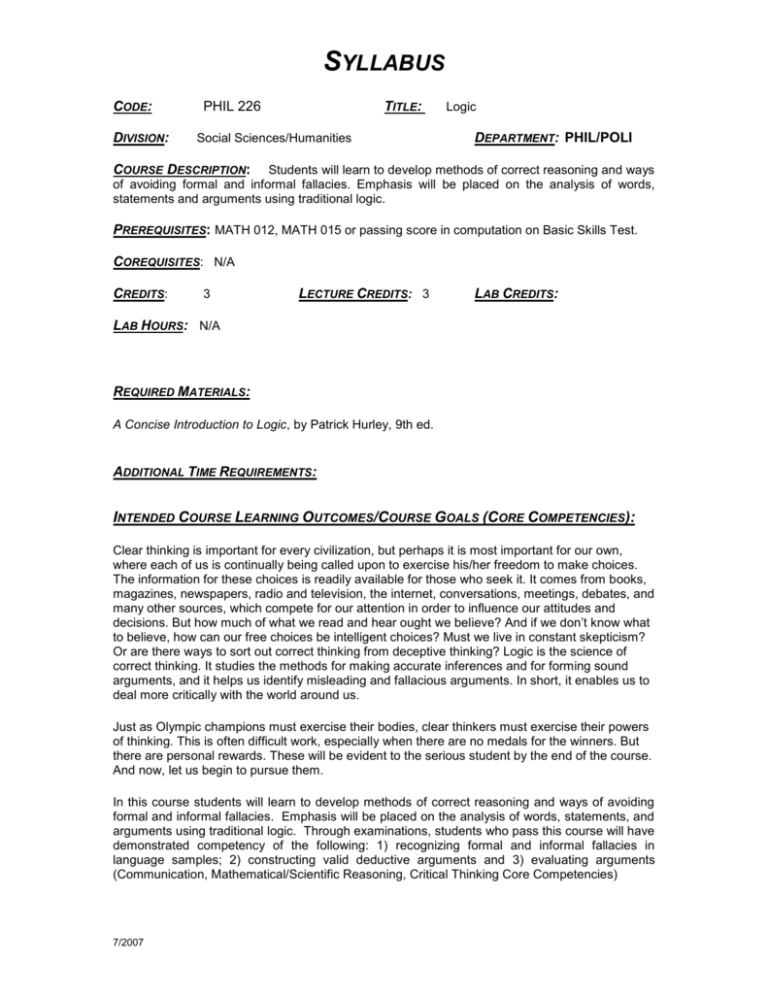
SYLLABUS CODE: DIVISION: PHIL 226 TITLE: Social Sciences/Humanities Logic DEPARTMENT: PHIL/POLI COURSE DESCRIPTION: Students will learn to develop methods of correct reasoning and ways of avoiding formal and informal fallacies. Emphasis will be placed on the analysis of words, statements and arguments using traditional logic. PREREQUISITES: MATH 012, MATH 015 or passing score in computation on Basic Skills Test. COREQUISITES: N/A CREDITS: 3 LECTURE CREDITS: 3 LAB CREDITS: LAB HOURS: N/A REQUIRED MATERIALS: A Concise Introduction to Logic, by Patrick Hurley, 9th ed. ADDITIONAL TIME REQUIREMENTS: INTENDED COURSE LEARNING OUTCOMES/COURSE GOALS (CORE COMPETENCIES): Clear thinking is important for every civilization, but perhaps it is most important for our own, where each of us is continually being called upon to exercise his/her freedom to make choices. The information for these choices is readily available for those who seek it. It comes from books, magazines, newspapers, radio and television, the internet, conversations, meetings, debates, and many other sources, which compete for our attention in order to influence our attitudes and decisions. But how much of what we read and hear ought we believe? And if we don’t know what to believe, how can our free choices be intelligent choices? Must we live in constant skepticism? Or are there ways to sort out correct thinking from deceptive thinking? Logic is the science of correct thinking. It studies the methods for making accurate inferences and for forming sound arguments, and it helps us identify misleading and fallacious arguments. In short, it enables us to deal more critically with the world around us. Just as Olympic champions must exercise their bodies, clear thinkers must exercise their powers of thinking. This is often difficult work, especially when there are no medals for the winners. But there are personal rewards. These will be evident to the serious student by the end of the course. And now, let us begin to pursue them. In this course students will learn to develop methods of correct reasoning and ways of avoiding formal and informal fallacies. Emphasis will be placed on the analysis of words, statements, and arguments using traditional logic. Through examinations, students who pass this course will have demonstrated competency of the following: 1) recognizing formal and informal fallacies in language samples; 2) constructing valid deductive arguments and 3) evaluating arguments (Communication, Mathematical/Scientific Reasoning, Critical Thinking Core Competencies) 7/2007 SYLLABUS INTENDED UNIT OUTCOME [UNIT OBJECTIVES] Unit I (Chapters 1, 3) By the end of Chapter 1, you should be able to 1. Define argument, truth value, premise, conclusion, reasoning, inference, proposition; 2. Distinguish between premises and conclusion 3. Recognize arguments and distinguish them from passages that lack inferential claims, from conditional statements, and from explanations; 4. Distinguish between inductive and deductive reasoning and list the major types of each; 5. Define validity, truth, soundness, strength, cogency; 6. Identify arguments that are valid, sound, strong and/or cogent; 7. Describe a substitution instance; 8. Use the counterexample method to demonstrate invalidity; 9. Diagram extended arguments; 10. Answer correctly the exercises at the end of each section of Chapter 1. By the end of Chapter 3, you should be able to 1. 2. 3. 4. Distinguish between formal and informal fallacies; Describe and give examples of the eight kinds of fallacies of relevance; Describe and give examples of the six kinds of fallacies of weak induction; Describe and give examples of the eight kinds of fallacies of presumption, ambiguity and grammatical analogy; 5. Detect fallacies in ordinary language; 6. Answer correctly the exercises at the end of each section of Chapter 3. Unit II (Chapter 4) By the end of Chapter 4, you should be able to 1. 2. 3. 4. 5. 6. 7. 8. 9. 10. 11. 12. Describe the components of a categorical proposition; Give the quantity, quality and letter name for categorical propositions; Determine the distribution of each term in a categorical proposition; Draw and interpret a Venn diagram; Determine the validity of selected arguments using the modern square of opposition; Describe the processes of conversion, obversion and contraposition; Illustrate conversion, obversion and contraposition with Venn diagrams; Determine the validity of selected arguments using conversion, obversion and contraposition; Determine the validiity of selected arguments using the modern square of opposition; Decide when to use the modern square and when to use the traditional square; Translate ordinary language into categorical form; Answer correctly the exercises at the end of each section of Chapter 4. Unit III (Chapter 5) By the end of Chapter 5, you will be able to 7/2007 SYLLABUS 1. Determine the major premise, minor premise, conclusion, figure and mood of categorical syllogisms; 2. Use a chart to determine which categorical syllogisms are unconditionally valid, conditionally valid, or invalid; 3. Use Venn diagrams to determine the validity of categorical syllogisms; 4. List and use the five rules to determine the validity of categorical syllogisms; 5. List and give examples of the corresponding five formal fallacies; 6. Reduce the number of terms in a syllogism to make it conform to standard form; 7. Translate ordinary language arguments into standard form; 8. Express the missing proposition in an enthymeme; 9. Determine the validity of an enthymeme; 10. Express the linkage in a sorites; 11. Determine the validity of a sorites; 12. Recognize the form and determine the validity of pure and mixed conditional syllogisms (not in text); 13. Recognize the form and determine the validity of exclusive and inclusive disjunctive syllogisms (not in text); 14. Answer correctly the exercises at the end of each section of Chapter 5. Unit IV (Chapter 6) By the end of Chapter 6 you should be able to 1. State the logical function, and translation of, the following five logical operators: tilde, dot, wedge, horseshoe, and triple bar. 2. Identify the following kinds of statements: negations, conjunctions, disjunctions, conditionals, and biconditionals. 3. Translate statements into symbolic form. 4. Recognize well-formed formulas (WFFs). I 5. Identify the main operator in a compound statement. 6. Give the definitions of each of the five logical operators via their truth tables. 7. Use the definitions of the five logical operators to compute the truth values of more complicated propositions. 8. Translate into symbolic form and determine truth values of ordinary language statements. 9. Construct truth tables of compound propositions. 10. Use truth tables to determine whether statements are tautologies, self-contradictory or contingent. 11. Use truth tables to determine whether pairs of statements are logically equivalent, contradictory, consistent or inconsistent. 12. Translate arguments into symbolic form, and, using truth tables, determine validity. 13. Use indirect truth tables to determine validity of arguments. 14. Recognize the following valid argument forms: disjunctive syllogism, pure hypothetical syllogism, modus ponens, modus tollens, constructive dilemma, and destructive dilemma. 15. Recognize the following invalid argument forms: affirming the consequent and denying the antecedent. 16. Answer correctly the exercises at the end of each section of Chapter 6. GRADING STANDARD: In order to receive an “A”, “B”, or “C” for this course each unit test must be passed with a minimum of 70%. There will be four unit tests. In the event of an initial failure on any test, you may retake the test one time, with a maximum acceptable score of 70%. 7/2007 SYLLABUS Unit tests will be graded according to the following scale: 100% to 90% A 89% to 87% B+ 86% to 80% B 79% to 77% C+ 76% to 70% C 69% to 60% D Below 60% F For a grade of 'A' a student must pass each of the 4 unit exams, and maintain an average of 90% or better. For a grade of ‘B+’ a student must pass each of the 4 unit exams, and maintain an average between 89-87. For a grade of 'B' a student must pass each of the 4 unit exams, and maintain an average between 86-80. For a grade of ‘C+’ a student must pass each of the 4 unit exams, and maintain an average between 79-77. For a grade of 'C' a student must pass each of the 4 unit exams and maintain an average between 76-70. Students with a cumulative average of 60% to 69% will earn a ‘D’. Students with a cumulative average below 60% will be given an ‘F’. DEPARTMENT POLICIES: Department Policies are in alignment with College Policies. COLLEGE POLICIES: For information regarding: Brookdale’s Academic Integrity Code Student Conduct Code Student Grade Appeal Process Please refer to the STUDENT HANDBOOK AND BCC CATALOG. NOTIFICATION FOR STUDENTS WITH DISABILITIES: Brookdale Community College offers reasonable accommodations and/or services to persons with disabilities. Students with disabilities who wish to self-identify, must contact the Disabilities Services Office at 732-224-2730 or 732-842-4211 (TTY), provide appropriate documentation of the disability, and request specific accommodations or services. If a student qualifies, reasonable accommodations and/or services, which are appropriate for the college level and are recommended in the documentation, can be approved. ADDITIONAL SUPPORT/LABS: A Learning Assistant is available 5 days each week (with varying hours each day) for individual and group tutoring and for testing. If you have any questions about the course material or concerns about the course, please call the Learning Assistant (224-2533) for an appointment. Drop-ins are also welcome. Brookdale provides this added resource free of charge to all students. Don't hesitate to take advantage of this help 7/2007 SYLLABUS 7/2007
